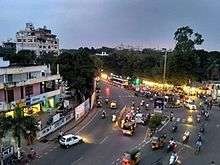Junction (road)
History
Roads began as a means of linking locations of interest: towns, forts and geographic features such as river fords. Where roads met outside of an existing settlement, these junctions often led to a new settlement. Scotch Corner is an example of such a location.
In the United Kingdom and other countries, the practice of giving names to junctions emerged, to help travellers find their way. Junctions took the name of a prominent nearby business or a point of interest.
As road networks increased in density and traffic flows followed suit, managing the flow of traffic across the junction became of increasing importance, to minimize delays and improve safety. The first innovation was to add traffic control devices, such as stop signs and traffic lights that regulated traffic flow. Next came lane controls that limited what each lane of traffic was allowed to do while crossing. Turns across oncoming traffic might be prohibited, or allowed only when oncoming and crossing traffic was stopped.
This was followed by specialized junction designs that incorporated information about traffic volumes, speeds, driver intent and many other factors.
Types
The most basic distinction among junction types is whether or not the roads cross at the same or different elevations. More expensive, grade-separated interchanges generally offer higher throughput at higher cost. Single-grade intersections are lower cost and lower throughput. Each main type comes in many variants.[1]
Interchange
At interchanges, roads pass above or below each other, using grade separation and slip roads. The terms motorway junction and highway junction typically refer to this layout. They can be further subdivided into those with and without signal controls.
Signalized (traffic-light controlled) interchanges include such "diamond" designs as the diverging diamond,[2] Michigan urban diamond, three-level diamond, and tight diamond. Others include center-turn overpass, contraflow left, single loop, and single-point urban overpass.[3]
Non-signalized designs include the cloverleaf, contraflow left, dogbone (restricted dumbbell), double crossover merging,[2][4][5] dumbbell (grade-separated bowtie), echelon, free-flow interchange, partial cloverleaf, raindrop, single and double roundabouts (grade-separated roundabout), single-point urban, stack, and windmill.[3]
Autobahnkreuz (literally autobahn cross), short form kreuz, and abbreviated as AK, is a four-way interchange on the German autobahn network. Autobahndreieck (literally autobahn triangle), short form dreieck, and abbreviated as AD, is a three-way interchange on the German autobahn network.
Intersection
At intersections, roads cross at-grade. They also can be further subdivided into those with and without signal controls.
Signalized designs include advanced stop line, bowtie, box junction, continuous-flow intersection,[6] continuous Green-T, double-wide, hook turn, jughandle, median u-turn, Michigan left, paired, quadrant, seagulls, slip lane, split, staggered, superstreet, Texas T, Texas U-turn and turnarounds.[3]
Non-signalized designs include unsignalized variations on continuous-flow 3 and 4-leg, median u-turn and superstreet, along with Maryland T/J, roundabout and traffic circle.[3]
Pedestrians
Intersections generally must manage pedestrian as well as vehicle traffic. Pedestrian aids include crosswalks, pedestrian-directed traffic signals ("walk light") and over/underpasses. Walk lights may be accompanied by audio signals to aid the visually impaired. Medians can offer pedestrian islands, allowing pedestrians to divide their crossings into a separate segment for each traffic direction, possibly with a separate signal for each.
Cyclists
Bicycle traffic can be accommodated with bike lanes in the roadway or bikeways that are physically separated from the roadway.
See also
References
- ↑ Hughes, Warren; Jagannathan, Ram; Sengupta, Dibu & Hummer, Joe (April 2010). Alternative Intersections/Interchanges: Informational Report (AIIR) (Report). Federal Highway Administration.
- 1 2 Hughes, Warren; Jagannathan, Ram (October 2009). "Double Crossover Diamond Interchange". Federal Highway Administration. FHWA-HRT-09-054. Retrieved April 22, 2012.
- 1 2 3 4 "Applied Technology and Traffic Analysis Program". University of Maryland. Retrieved 2014-04-12.
- ↑ "Double Crossover Merging Interchange".
- ↑ Gingrich, Michael A., Sr. (June 2011). "DCMI (Double Crossover Merging Interchange)" (PDF). Institute of Transportation Engineers. Retrieved January 23, 2013.
- ↑ Hummer, Joseph E. and Jonathan D. Reid. "Unconventional Left-Turn Alternatives for Urban and Suburban Arterials" (PDF). Transportation Research Board. Retrieved 13 June 2007.

